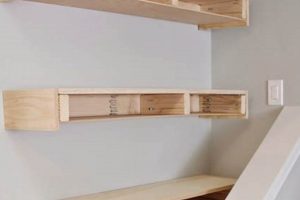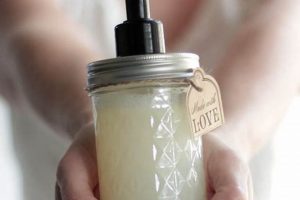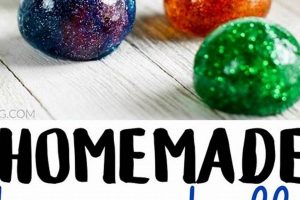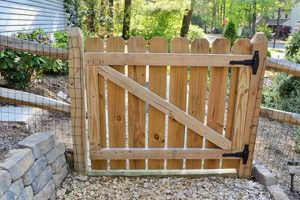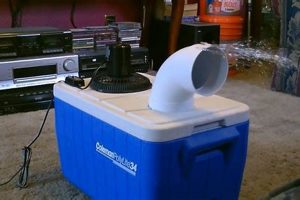A homemade cleaning liquid intended for use with floor mops provides an alternative to commercially available products. Typically, these mixtures involve combining readily accessible household ingredients to create an effective and economical cleaning agent. An example includes mixing water, vinegar, and a few drops of essential oil.
The appeal of formulating cleaning solutions in-house lies in the ability to control ingredients, avoid potentially harsh chemicals found in store-bought options, and reduce expenditure. Historically, homemade cleaners were a necessity; now, they represent a conscious choice towards sustainability and personalized cleaning practices.
The subsequent sections will explore various formulations for floor cleaning, discussing the optimal ratios of ingredients, suitable applications for different flooring types, and safety precautions to consider when preparing and utilizing these homemade cleaning agents.
Formulating Effective Floor Cleaning Liquids
The following tips provide guidance on creating efficient and safe cleaning solutions for mop application, utilizing common household ingredients.
Tip 1: Ingredient Selection: Prioritize ingredients known for their cleaning properties. White vinegar, for example, exhibits excellent degreasing and deodorizing capabilities.
Tip 2: Dilution Ratios: Adhere to recommended dilution ratios. An overly concentrated solution may damage certain floor surfaces, while an under-concentrated solution may not provide adequate cleaning.
Tip 3: Flooring Compatibility: Consider the flooring material. Wood floors generally require pH-neutral solutions to prevent damage to the finish. Test any solution on an inconspicuous area before applying it to the entire floor.
Tip 4: Water Temperature: Utilize warm water to enhance the cleaning power. Warm water aids in dissolving dirt and grime, facilitating a more thorough cleaning process.
Tip 5: Essential Oil Addition: Incorporate essential oils cautiously. While some oils possess antibacterial properties, others may stain or damage certain surfaces. Use them sparingly and select oils appropriate for the flooring type.
Tip 6: Storage Considerations: Store the prepared solution in a clearly labeled container, out of reach of children and pets. This helps prevent accidental ingestion or misuse.
Tip 7: Residue Removal: After mopping, ensure any remaining solution is thoroughly rinsed or dried to prevent residue buildup, which can attract dirt and create a dull appearance.
By carefully selecting ingredients, adhering to proper dilution ratios, and considering flooring material compatibility, effective and safe floor cleaning solutions can be created using readily available resources.
The subsequent section will address specific cleaning solutions tailored for different floor types, providing detailed formulations and application guidelines.
1. Ingredient Selection
Ingredient selection forms a foundational element within the creation of effective homemade floor cleaning solutions. The constituent components directly influence the cleaning power, safety, and suitability of the solution for specific flooring types. Inadequate ingredient selection can lead to ineffective cleaning, surface damage, or potential health hazards. For example, the use of abrasive agents like baking soda on delicate hardwood floors can result in scratching and permanent damage. Conversely, selecting an overly diluted or chemically inert substance may fail to remove stubborn stains or disinfect the surface adequately.
The relationship between ingredient selection and floor type dictates the success of any floor cleaning endeavor. Acidic substances, such as vinegar, can effectively cut through grease and grime on tile or vinyl flooring but may etch or dull natural stone surfaces like marble or granite. Similarly, certain essential oils, while imparting a pleasant scent, can discolor or damage wood finishes. A strategic approach to ingredient selection requires considering the chemical properties of each component and its interaction with the target flooring material. A solution formulated with water, pH-neutral soap, and a small amount of tea tree oil can be suitable for cleaning sealed hardwood floors, whereas a stronger alkaline solution might be necessary for heavily soiled concrete floors.
Therefore, thoughtful ingredient selection is not merely a matter of convenience; it represents a critical determinant of the outcome and longevity of any floor cleaning regimen. It necessitates a basic understanding of chemical reactions, material properties, and safety considerations. Ultimately, informed ingredient selection ensures the creation of an efficient, safe, and floor-appropriate cleaning solution, extending the lifespan and maintaining the aesthetic appeal of various flooring surfaces.
2. Dilution Precision
Dilution precision constitutes a critical factor in the efficacy and safety of homemade floor cleaning liquids. Improper dilution directly influences cleaning performance, material compatibility, and potential health risks. Inadequate dilution may result in a solution that is either too weak to effectively remove dirt and grime or too concentrated, leading to surface damage or the formation of a sticky residue. For example, an excessively concentrated vinegar solution can etch or discolor certain types of flooring, while an under-diluted solution might fail to disinfect effectively, leaving behind pathogens and unpleasant odors.
The relationship between dilution and cleaning outcome necessitates a clear understanding of the chemical properties of the chosen ingredients. The appropriate dilution ratio hinges on the concentration of the cleaning agent and the type of flooring being cleaned. Specific formulations, such as those utilizing concentrated essential oils for their antibacterial properties, require precise dilution to prevent skin irritation or allergic reactions. Accurate measurement, often employing measuring cups or calibrated containers, is essential to achieve the desired concentration. Real-world examples include using a 1:10 ratio of bleach to water for disinfecting tile floors versus a 1:100 ratio for delicate wood surfaces, highlighting the importance of tailored dilution strategies. Failing to follow these guidelines can lead to adverse consequences, underscoring the practical significance of accurate dilution.
In summary, dilution precision represents a core principle in the successful formulation and application of floor cleaning liquids. Maintaining appropriate dilution ratios ensures effective cleaning, prevents material damage, and safeguards the health of users. While the ease of creating floor cleaners at home provides numerous benefits, precise dilution presents a crucial aspect that should not be overlooked. Accurately controlling dilution levels results in a product that is both ef
ficient and safe, while failure to do so can undermine the entire endeavor, leading to both unsatisfactory cleaning results and potential risks.
3. Flooring Compatibility
Flooring compatibility represents a paramount consideration in the context of do-it-yourself floor cleaning liquids. The selection and formulation of such solutions must align with the specific material composition and finish of the flooring to prevent damage, discoloration, or premature wear. Incompatibility can result in irreversible harm, negating the cost and environmental benefits of a homemade solution.
- pH Sensitivity
Certain flooring materials, such as natural stone (marble, limestone, travertine), exhibit sensitivity to acidic or alkaline cleaning agents. Solutions with extreme pH levels can etch or dull these surfaces, compromising their aesthetic appearance. A pH-neutral solution is generally recommended for these sensitive materials. Conversely, some sealed surfaces may tolerate mildly acidic solutions, such as those containing diluted vinegar, which can effectively remove hard water stains and mineral deposits.
- Moisture Tolerance
Wood flooring, particularly unsealed or improperly sealed varieties, is susceptible to moisture damage. Excessive water absorption can lead to warping, swelling, or the growth of mold and mildew. Cleaning solutions intended for wood floors should be applied sparingly, and excess moisture should be promptly removed. The use of steam mops on unsealed wood is generally discouraged due to the risk of water penetration.
- Finish Reactivity
The finish applied to a floor can react adversely to certain chemicals present in homemade cleaning solutions. For example, ammonia-based cleaners can strip the protective coating from waxed floors, leaving them vulnerable to damage and requiring reapplication of the finish. Similarly, abrasive cleaning agents can scratch or dull the finish on polyurethane-coated floors, diminishing their shine and durability.
- Material Porosity
Porous flooring materials, such as unglazed tile or grout, are prone to absorbing cleaning solutions, potentially leading to staining or discoloration. Solutions containing dyes or strong pigments should be avoided on these surfaces. Furthermore, residues from cleaning agents can accumulate within the pores, creating a breeding ground for bacteria and contributing to unpleasant odors. Thorough rinsing is essential to remove any residual cleaning solution from porous surfaces.
In conclusion, ensuring flooring compatibility is not merely a matter of aesthetic preservation but also one of structural integrity and hygiene. The effectiveness and longevity of do-it-yourself floor cleaning methods depend on a thorough understanding of the material properties of the flooring and the potential interactions with various cleaning agents. Prior testing in an inconspicuous area is always recommended before applying a homemade solution to the entire floor surface.
4. Solution pH Balance
The pH balance of a do-it-yourself floor cleaning liquid critically influences its efficacy and compatibility with different flooring materials. Maintaining the appropriate pH level is essential for effective cleaning, preventing surface damage, and ensuring user safety.
- Cleaning Efficacy and pH
The pH level of a cleaning solution directly affects its ability to remove specific types of soil and stains. Acidic solutions (pH less than 7) are effective at dissolving mineral deposits, hard water stains, and soap scum. Conversely, alkaline solutions (pH greater than 7) excel at cutting through grease, oils, and organic matter. A pH-neutral solution (pH around 7) offers a balanced cleaning approach suitable for general-purpose cleaning without posing a significant risk of surface damage. An incorrectly balanced pH can lead to diminished cleaning performance, requiring increased effort or multiple applications.
- Material Compatibility and pH
Different flooring materials exhibit varying levels of tolerance to acidic and alkaline substances. Natural stone, such as marble and limestone, is particularly sensitive to acidic cleaners, which can etch or dull the surface. Wood flooring can be damaged by highly alkaline solutions, leading to discoloration or degradation of the finish. Vinyl and tile flooring generally tolerate a wider range of pH levels but may still be affected by prolonged exposure to highly acidic or alkaline solutions. A carefully balanced pH ensures that the cleaning solution is effective without causing irreversible damage to the flooring material.
- Buffering Capacity
The buffering capacity of a cleaning solution refers to its ability to resist changes in pH when exposed to acidic or alkaline substances. Solutions with high buffering capacity maintain a stable pH level, ensuring consistent cleaning performance and minimizing the risk of damage. Homemade cleaning solutions may lack the buffering agents found in commercial products, making them more susceptible to pH fluctuations. Monitoring and adjusting the pH of homemade solutions is essential to maintain their effectiveness and prevent unintended consequences.
- Safety Considerations
The pH of a cleaning solution directly impacts its safety for users. Highly acidic or alkaline solutions can cause skin irritation, burns, or respiratory distress upon contact or inhalation. Proper handling precautions, including the use of gloves and adequate ventilation, are essential when working with cleaning solutions of extreme pH levels. Diluting concentrated solutions to achieve a neutral or mildly acidic pH can significantly reduce the risk of adverse health effects.
The pH balance of do-it-yourself floor cleaning solutions represents a critical determinant of their overall effectiveness and safety. A thorough understanding of pH principles, material compatibility, and safety precautions is essential for formulating solutions that clean effectively without causing damage or posing health risks. The specific pH target should be tailored to the flooring material and the type of soil or stain being addressed, while maintaining a safe and user-friendly profile.
5. Residue Minimization
Residue minimization plays a crucial role in the creation and application of effective do-it-yourself floor cleaning solutions. The presence of excessive residue can diminish cleaning performance, attract dirt and grime, and negatively impact the appearance and safety of flooring surfaces.
- Ingredient Purity and Formulation
The purity of ingredients utilized in homemade floor cleaning solutions directly influences the amount of residue left behind. Commercial cleaning products often contain additives that enhance solubility and prevent residue buildup. DIY solutions, relying on simpler formulations, require careful selection of high-quality ingredients to minimize impurities. For example, using distilled water instead of tap water reduces mineral deposits, while selecting pure castile soap minimizes oily residue
s. - Dilution and Application Technique
Over-concentration of cleaning solutions, regardless of their composition, contributes to excessive residue. Precise adherence to recommended dilution ratios is essential. Furthermore, application technique significantly impacts residue levels. Employing a damp mop rather than a saturated one prevents the pooling of solution and subsequent residue accumulation. Regular rinsing of the mop head during the cleaning process further minimizes the spread of residual cleaning agents.
- Floor Type and Porosity
The material properties of the flooring surface influence the ease with which residue is removed. Porous surfaces, such as unsealed grout or natural stone, tend to trap cleaning solutions, making residue removal more challenging. Non-porous surfaces, such as sealed vinyl or tile, are less susceptible to residue buildup. Selecting appropriate cleaning solutions and application techniques tailored to the floor type is crucial for effective residue minimization.
- Post-Cleaning Procedures
Implementing proper post-cleaning procedures is vital for minimizing residue. Rinsing the floor with clean water after the initial cleaning pass effectively removes residual cleaning agents. Drying the floor thoroughly, either with a clean microfiber cloth or through natural air circulation, prevents water spots and further reduces residue accumulation. Implementing these steps contributes to a cleaner, safer, and more aesthetically pleasing floor surface.
The interrelation of ingredient selection, dilution precision, floor type consideration, and post-cleaning procedures significantly impacts residue levels associated with do-it-yourself floor cleaning methods. Optimizing each of these facets contributes to a cleaner and longer-lasting result, further enhancing the appeal of creating cleaning solutions from readily available resources.
6. Safety Protocol
The implementation of stringent safety protocols is paramount when creating and utilizing homemade floor cleaning liquids. The absence of standardized formulations and quality control measures inherent in commercially available products necessitates rigorous adherence to safety guidelines to mitigate potential hazards.
- Chemical Compatibility and Reactivity
DIY formulations often involve combining household chemicals that, while individually safe, may produce hazardous reactions when mixed. For instance, combining vinegar (acetic acid) with bleach (sodium hypochlorite) generates chlorine gas, a potent respiratory irritant. Prior to combining any ingredients, a thorough understanding of their chemical properties and potential reactivity is essential. Consulting safety data sheets (SDS) for each component provides crucial information regarding potential hazards and safe handling procedures.
- Appropriate Ventilation and Personal Protective Equipment
The preparation and application of homemade floor cleaning liquids should occur in well-ventilated areas to minimize inhalation of potentially harmful vapors. Furthermore, the use of appropriate personal protective equipment (PPE) is crucial to prevent skin and eye irritation. Chemical-resistant gloves protect the skin from direct contact with cleaning solutions, while safety glasses or goggles shield the eyes from splashes or accidental exposure. Inhalation of certain volatile organic compounds (VOCs) present in essential oils or other additives can be minimized through the use of a respirator if adequate ventilation is not achievable.
- Proper Labeling and Storage
Homemade cleaning solutions must be clearly labeled with the contents, date of preparation, and any relevant hazard warnings. This prevents accidental misuse or ingestion, particularly in households with children or individuals with impaired cognitive function. Solutions should be stored in tightly sealed, opaque containers in a cool, dry location, away from direct sunlight and sources of heat or ignition. Separate storage of cleaning solutions from food items and medications is essential to prevent accidental contamination.
- Safe Disposal Procedures
The improper disposal of unused homemade cleaning solutions can pose environmental hazards. Solutions containing hazardous chemicals should not be poured down drains or into waterways. Instead, consult local waste management guidelines for proper disposal methods. In some cases, hazardous waste collection programs may be available to safely dispose of chemical waste. Diluting solutions with large volumes of water prior to disposal can minimize environmental impact in certain situations, but this approach should be verified with local regulations.
The multifaceted nature of safety protocols when formulating and using homemade floor cleaning solutions underscores the need for diligence and informed decision-making. By adhering to established safety guidelines, individuals can mitigate potential risks and enjoy the benefits of DIY cleaning while minimizing potential harm to themselves, their families, and the environment.
7. Cost-Effectiveness
Cost-effectiveness serves as a primary motivator for individuals and organizations to explore do-it-yourself floor cleaning solutions. This facet encompasses not only direct material costs but also indirect savings derived from reduced consumption of commercial products and potentially decreased expenditure on floor maintenance.
- Reduced Material Costs
DIY floor cleaning solutions typically utilize readily available household ingredients such as water, vinegar, baking soda, and essential oils. The cost of these components is often significantly lower than pre-packaged commercial cleaning products. For example, a gallon of white vinegar, a common ingredient in homemade solutions, typically costs a fraction of a comparable volume of commercial floor cleaner. Long-term use can result in substantial savings.
- Lower Packaging and Waste Disposal Costs
Commercial cleaning products generate significant packaging waste, contributing to landfill burden and associated disposal costs. DIY solutions, prepared in reusable containers, substantially reduce packaging waste. This translates into cost savings for waste disposal services, either directly through reduced waste volume or indirectly through lower municipal waste management fees.
- Decreased Consumption of Commercial Products
Formulating cleaning solutions in-house reduces reliance on commercial products. This lessens the need to purchase specialized cleaning agents for different flooring types. A versatile DIY solution, tailored to specific needs through minor adjustments, can replace multiple commercial products, leading to consolidated purchasing and reduced overall spending.
- Potential for Reduced Floor Maintenance Costs
Utilizing gentler cleaning solutions, often characteristic of DIY formulations, can prolong the lifespan of flooring materials and finishes. Harsh chemicals present in some commercial products can accelerate wear and tear, necessitating more frequent repairs or replacements. By opting for milder DIY solutions, flooring surfaces may require less intensive maintenance, potentially decreasing long-term maintenance costs. However, this benefit relies hea
vily on correct solution formulation and proper application techniques.
The aforementioned facets collectively illustrate the cost-effectiveness benefits inherent in DIY floor cleaning solutions. While initial material costs represent a significant advantage, the cumulative savings from reduced packaging waste, decreased reliance on commercial products, and the potential for prolonged floor lifespan further amplify the financial appeal. These factors often outweigh the time investment required for solution preparation, making DIY solutions a financially prudent choice for many consumers.
Frequently Asked Questions
The following addresses common inquiries regarding the formulation, application, and safety of homemade floor cleaning solutions.
Question 1: Can a “diy mop solution” effectively disinfect floors, or is a commercial disinfectant necessary?
Disinfection efficacy depends on the ingredients utilized. Solutions containing appropriate concentrations of substances such as bleach, hydrogen peroxide, or certain essential oils can exhibit disinfecting properties. However, ensure proper dilution and contact time as specified by relevant health authorities for each disinfectant agent. Commercial disinfectants often offer standardized concentrations and testing for efficacy against specific pathogens.
Question 2: What types of flooring are unsuitable for cleaning with a homemade mop solution?
Certain flooring types, including unfinished wood, natural stone (marble, limestone), and waxed floors, may be susceptible to damage from specific homemade solutions. Acidic solutions, such as those containing vinegar or lemon juice, can etch natural stone. Excessive moisture can damage wood. Abrasive ingredients can scratch delicate finishes. Always test any solution on an inconspicuous area before applying it to the entire floor.
Question 3: How does the shelf life of a “diy mop solution” compare to commercial alternatives?
Homemade solutions typically have a shorter shelf life than commercial products, which often contain preservatives. Solutions without preservatives are prone to bacterial growth or degradation over time. It is advisable to prepare solutions in small batches and use them within a week. Solutions containing volatile ingredients, such as essential oils, may lose potency over time.
Question 4: Are there specific safety precautions to observe when creating and utilizing a “diy mop solution”?
Safety precautions are crucial. Never mix bleach with ammonia or vinegar, as this can produce toxic gases. Wear gloves to protect skin from irritation. Ensure adequate ventilation when using solutions with strong odors or volatile ingredients. Store solutions out of reach of children and pets. Clearly label all containers with the contents and date of preparation.
Question 5: How can the pH level of a “diy mop solution” be tested and adjusted for optimal floor compatibility?
The pH level can be tested using pH test strips or a digital pH meter, available at most hardware stores. Adjustments can be made by adding small amounts of acidic substances (e.g., vinegar) to lower the pH or alkaline substances (e.g., baking soda) to raise the pH. Exercise caution when making adjustments, and retest the pH after each addition. A pH-neutral solution (around 7) is generally suitable for most flooring types.
Question 6: Does using a “diy mop solution” void any warranties on flooring products?
The use of homemade cleaning solutions may void warranties on certain flooring products, particularly if the solution causes damage not covered by the warranty terms. Consult the flooring manufacturer’s warranty documentation for specific cleaning recommendations and exclusions. If uncertainty exists, contacting the manufacturer directly is advisable.
In summary, the effective and safe application of homemade floor cleaning solutions necessitates a thorough understanding of ingredient properties, flooring material compatibility, and adherence to strict safety protocols. Prior research and cautious experimentation are encouraged.
The subsequent section will provide detailed recipes for various floor types, incorporating the principles outlined in this article.
DIY Mop Solution
The preceding analysis has explored the multifaceted nature of formulating homemade floor cleaning solutions. Considerations encompassing ingredient selection, dilution precision, flooring compatibility, pH balance, residue minimization, safety protocols, and cost-effectiveness were addressed. The efficacy and safety of such solutions hinge upon a thorough understanding of these interrelated factors and a commitment to meticulous execution.
The implementation of DIY solutions represents a conscious choice predicated on informed decision-making and a dedication to responsible practices. The long-term success of this approach depends on continued vigilance in adhering to established guidelines and adapting formulations to the specific demands of each environment. The future of floor cleaning may well involve a greater emphasis on sustainable and personalized approaches, yet the onus remains on the practitioner to ensure both efficacy and safety are paramount.


